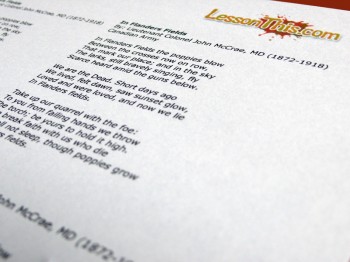Lesson Plans for Elementary School Students
Reading Lesson Plan: In Flanders Fields by John McCrae
 I have had my class memorize this poem, using hand and arm movements to “illustrate” the poem. This makes it easy for them to remember the words and much more interesting to watch them recite it for other classes or parents. We read the poem through, talking about what it means, then we decide what “actions” we can use to “illustrate” it. This does take a lot of repetition and practise, but my students love to do it.
I have had my class memorize this poem, using hand and arm movements to “illustrate” the poem. This makes it easy for them to remember the words and much more interesting to watch them recite it for other classes or parents. We read the poem through, talking about what it means, then we decide what “actions” we can use to “illustrate” it. This does take a lot of repetition and practise, but my students love to do it.
In Flanders Fields (In Flanders Fields PDF)
By: Lieutenant Colonel John McCrae, MD (1872-1918)
Canadian Army
In Flanders Fields the poppies blow
Between the crosses row on row,
That mark our place; and in the sky
The larks, still bravely singing, fly
Scarce heard amid the guns below.
We are the Dead. Short days ago
We lived, felt dawn, saw sunset glow,
Loved and were loved, and now we lie
In Flanders fields.
Take up our quarrel with the foe:
To you from failing hands we throw
The torch; be yours to hold it high.
If ye break faith with us who die
We shall not sleep, though poppies grow
In Flanders fields.
Objectives:
- read the poem
- memorize the poem
- use creativity to “illustrate” the poem
Materials:
- transparency (overhead sheet) with the above poem printed on it
- overhead projector
- copies of poem “shrunk” to 25% so that 6 copies fit on an 8 1/2″ X 11″ sheet of white paper
- scissors
- white glue
- school journal labelled “Poem Book” where class poems and songs are collected
Method:
- Before class, shrink poem to 25% on photocopier, then paste 6 copies on 8 1/2″ X 11″ sheet of white paper. This is now your master sheet for next year.
- Before class, copy this sheet 4 or 5 times so that you have a copy of the poem for each student.
- Before class, cut out each poem.
- At beginning of class, talk about John McCrae, Remembrance Day, and briefly ask students what they know about war. Tell them that McCrae was a doctor and a surgeon who wrote the poem in May 1915, the day after a friend and former student’s death. He was so upset, he had to vent; he did this by writing the poem. The poppies were blowing in a cemetery nearby, where his friend lay. It took him 20 minutes to write the 15 lines. Later, he was unhappy with it and threw it away. Another soldier sent it to newspapers in England where it eventually got published in December of 1915.
- During lesson, put transparency on overhead projector. Read the poem to the students. Stop at the end of each line and talk about what it means.
- Figure out some actions. Ask them to show you how you could show poppies blowing (arms up and waving back and forth)…what happens at dawn and sunset (sun comes up and goes down)? How can we show that? (make a ball with your hands and move in a semi-circle in front of you from left to right like a sunrise to sunset) What’s a foe? (enemy)
- Examples of the actions, line by line:
- Read the poem to them once again, with them doing the actions as you read it.
- Have them read it to you, with you doing the actions.
- Hand out the students’ copies of the poem to glue in their Poem Book.
- Practise lots…after morning announcements, before going out for recess, before leaving for lunch, before hometime…
- Recite for Remembrance Day assembly or invite other classrooms in to hear your class. Perhaps you could visit another classroom and recite it for them.
My students loved to recite and “illustrate” this poem the whole year. When we had time to read our Poem Book during the day, this verse was often chosen by the students to read, but because they knew it so well, we stood up and just watched as everyone recited it and did the “actions”. Fun!!!!
Tags: creativity, poem, reading
